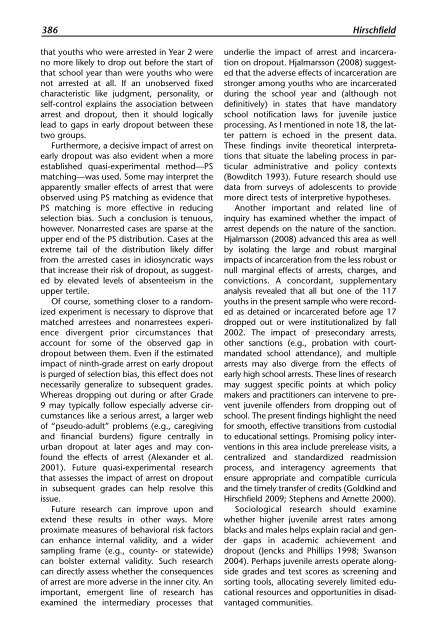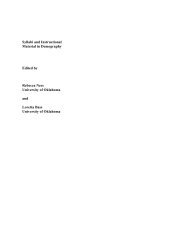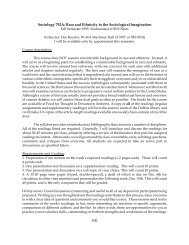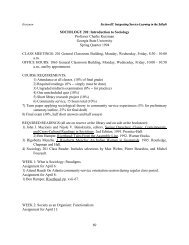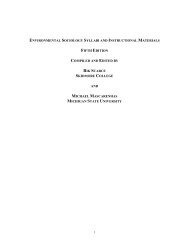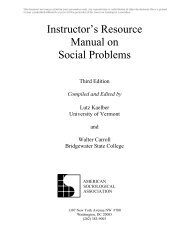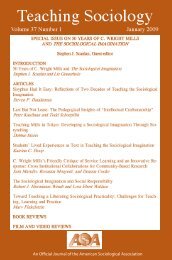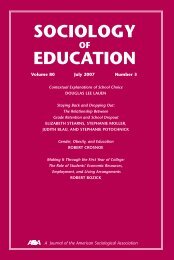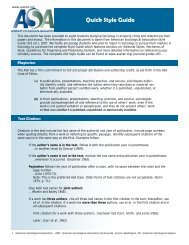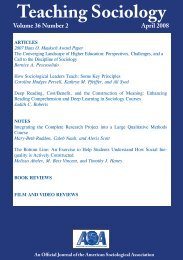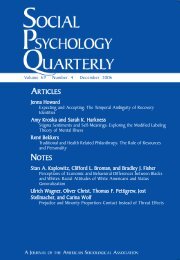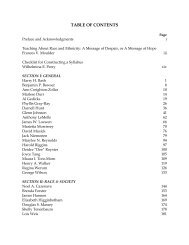SOCIOLOGY EDUCATION - American Sociological Association
SOCIOLOGY EDUCATION - American Sociological Association
SOCIOLOGY EDUCATION - American Sociological Association
You also want an ePaper? Increase the reach of your titles
YUMPU automatically turns print PDFs into web optimized ePapers that Google loves.
386 Hirschfield<br />
that youths who were arrested in Year 2 were<br />
no more likely to drop out before the start of<br />
that school year than were youths who were<br />
not arrested at all. If an unobserved fixed<br />
characteristic like judgment, personality, or<br />
self-control explains the association between<br />
arrest and dropout, then it should logically<br />
lead to gaps in early dropout between these<br />
two groups.<br />
Furthermore, a decisive impact of arrest on<br />
early dropout was also evident when a more<br />
established quasi-experimental method—PS<br />
matching—was used. Some may interpret the<br />
apparently smaller effects of arrest that were<br />
observed using PS matching as evidence that<br />
PS matching is more effective in reducing<br />
selection bias. Such a conclusion is tenuous,<br />
however. Nonarrested cases are sparse at the<br />
upper end of the PS distribution. Cases at the<br />
extreme tail of the distribution likely differ<br />
from the arrested cases in idiosyncratic ways<br />
that increase their risk of dropout, as suggested<br />
by elevated levels of absenteeism in the<br />
upper tertile.<br />
Of course, something closer to a randomized<br />
experiment is necessary to disprove that<br />
matched arrestees and nonarrestees experience<br />
divergent prior circumstances that<br />
account for some of the observed gap in<br />
dropout between them. Even if the estimated<br />
impact of ninth-grade arrest on early dropout<br />
is purged of selection bias, this effect does not<br />
necessarily generalize to subsequent grades.<br />
Whereas dropping out during or after Grade<br />
9 may typically follow especially adverse circumstances<br />
like a serious arrest, a larger web<br />
of “pseudo-adult” problems (e.g., caregiving<br />
and financial burdens) figure centrally in<br />
urban dropout at later ages and may confound<br />
the effects of arrest (Alexander et al.<br />
2001). Future quasi-experimental research<br />
that assesses the impact of arrest on dropout<br />
in subsequent grades can help resolve this<br />
issue.<br />
Future research can improve upon and<br />
extend these results in other ways. More<br />
proximate measures of behavioral risk factors<br />
can enhance internal validity, and a wider<br />
sampling frame (e.g., county- or statewide)<br />
can bolster external validity. Such research<br />
can directly assess whether the consequences<br />
of arrest are more adverse in the inner city. An<br />
important, emergent line of research has<br />
examined the intermediary processes that<br />
underlie the impact of arrest and incarceration<br />
on dropout. Hjalmarsson (2008) suggested<br />
that the adverse effects of incarceration are<br />
stronger among youths who are incarcerated<br />
during the school year and (although not<br />
definitively) in states that have mandatory<br />
school notification laws for juvenile justice<br />
processing. As I mentioned in note 18, the latter<br />
pattern is echoed in the present data.<br />
These findings invite theoretical interpretations<br />
that situate the labeling process in particular<br />
administrative and policy contexts<br />
(Bowditch 1993). Future research should use<br />
data from surveys of adolescents to provide<br />
more direct tests of interpretive hypotheses.<br />
Another important and related line of<br />
inquiry has examined whether the impact of<br />
arrest depends on the nature of the sanction.<br />
Hjalmarsson (2008) advanced this area as well<br />
by isolating the large and robust marginal<br />
impacts of incarceration from the less robust or<br />
null marginal effects of arrests, charges, and<br />
convictions. A concordant, supplementary<br />
analysis revealed that all but one of the 117<br />
youths in the present sample who were recorded<br />
as detained or incarcerated before age 17<br />
dropped out or were institutionalized by fall<br />
2002. The impact of presecondary arrests,<br />
other sanctions (e.g., probation with courtmandated<br />
school attendance), and multiple<br />
arrests may also diverge from the effects of<br />
early high school arrests. These lines of research<br />
may suggest specific points at which policy<br />
makers and practitioners can intervene to prevent<br />
juvenile offenders from dropping out of<br />
school. The present findings highlight the need<br />
for smooth, effective transitions from custodial<br />
to educational settings. Promising policy interventions<br />
in this area include prerelease visits, a<br />
centralized and standardized readmission<br />
process, and interagency agreements that<br />
ensure appropriate and compatible curricula<br />
and the timely transfer of credits (Goldkind and<br />
Hirschfield 2009; Stephens and Arnette 2000).<br />
<strong>Sociological</strong> research should examine<br />
whether higher juvenile arrest rates among<br />
blacks and males helps explain racial and gender<br />
gaps in academic achievement and<br />
dropout (Jencks and Phillips 1998; Swanson<br />
2004). Perhaps juvenile arrests operate alongside<br />
grades and test scores as screening and<br />
sorting tools, allocating severely limited educational<br />
resources and opportunities in disadvantaged<br />
communities.


